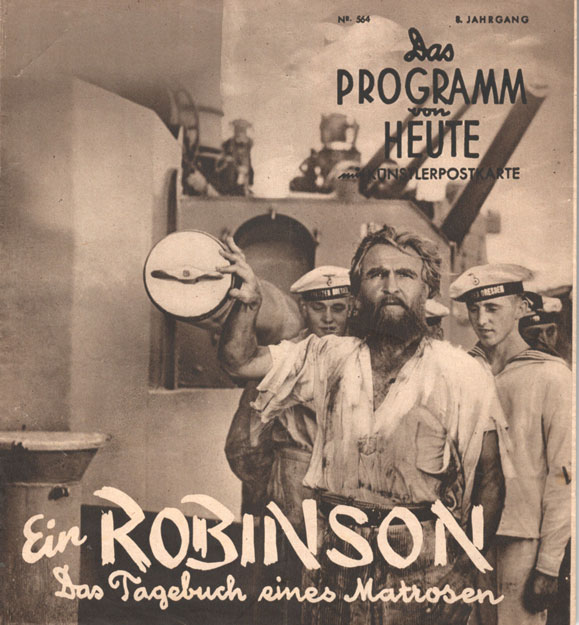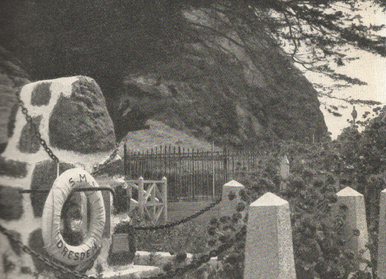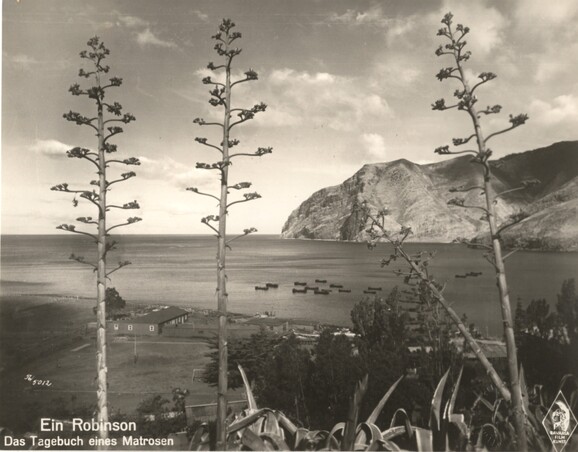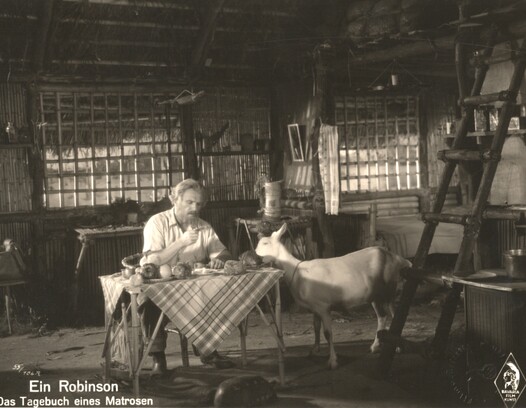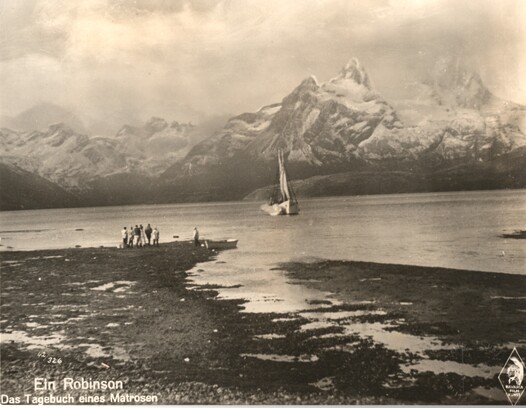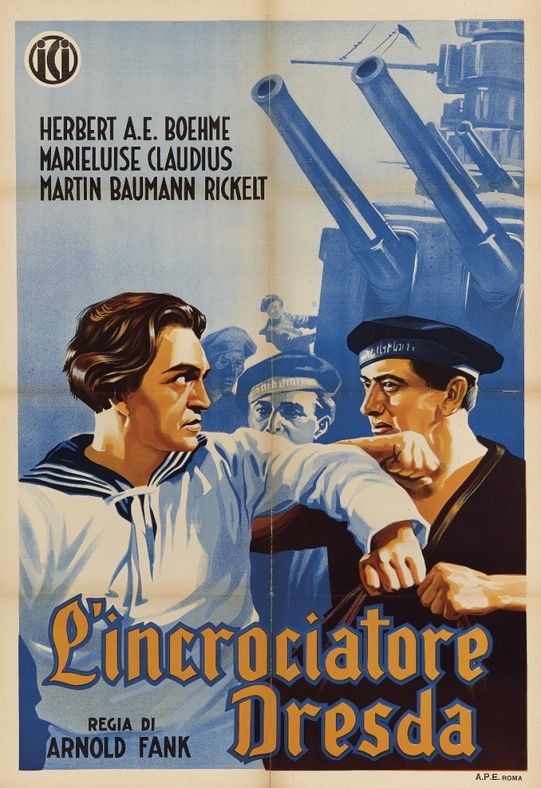- Home
- POSTER GALLERY
- ❗️BOOK & POSTER STORE❗️
- About the Posters
- The William Gillespie Collection
- Our Publishing House
- ❗️GFDN interviews author and collector William Gillespie ❗️
- Our most expensive & inexpensive finds!
- ❗️***NEW!*** Poster of the Month ❗️
- ❗️NEW ❗️Film Posters – Demands on an important means of film advertising. ❗️
- In our Book + Zeitschrift Library
- ❗️ ***NEW!*** Hitler Youth Quex – A Guide for the English–speaking Reader ***NEW!*** ❗️
- ❗️***NEW!*** Table of Contents of our new HJ QUEX book❗️
- ❗️Hitler Youth Quex Guide - early praise! ❗️
- Recent loans from the Collection
- Farewell Horst Claus. (1940–2024)
- "Der Deutsche Film" Zeitschrift
- ❗️ ***NEW!***German "Tendency" Films (Tendenzfilme) in the Third Reich ❗️
- KARL RITTER
- Karl Ritter original film posers in this Collection
- "Besatzung Dora" ( † 1943)
- "The Making of The Crew of the Dora"
- Karl Ritter at the 1938 Reichsfilmkammer Congress
- INDEX -"Karl Ritter" book, 2nd edition
- Karl Ritter's Legion Condor (1939, unfinished)
- Excerpt from our "Dora" book
- ∆∆∆∆∆ High praise for our DORA book! ∆∆∆∆∆
- TABLE OF CONTENTS – "Legion Condor"
- § § § § § Early Praise for our LEGION CONDOR book! § § § § §
- ❗️"Das Leben geht weiter" and Karl Ritter ❗️
- Zarah Leander Europe–wide !
- Japan Military Film and Karl Ritter
- Karl Ritter after 1945
- 1935 Film Congress
- Poster Exhibition in Berlin, March 1939
- Potsdam poster exhibition 12 April–25 August 2019
- Leni Riefenstahl's two "Olympia" Films (1938)
- "Ohm Krüger" (1941)
- Emil Jannings
- "Blutendes Deutschland" (1933)
- Hannes Stelzer ( † 1944)
- Klaus Detlef Sierck ( † 1944)
- Film stills
- Reich Film Censorship Offices
- ❗️Dateline: Ufa - April 11, 1945 ❗️
- ❗️***NEW!***The Fate of the German Film Industry in May 1945 ❗️
- Film censorship cards
- Film Archives
- Cinema advertising
- School filmstrips
- ❗️UPDATED❗️ Z F O / Ostland Film G-m-b-H
- Z F O / Herbert Jacobi estate
- ZFO / Ostland Film newspaper articles
- ❗️***NEW!*** Roter Nebel / Red Fog / Red Mist (1942/1943, ZFO) ❗️
- ZFO - Der Rückkehrer - The Returnee (1943/1944)
- The D F G production company
- D I F U
- ❗️ ***NEW!*** "Carl Peters" – Special Collection. ❗️
- "Alcazar" (1940, Genina)
- "Der 5. Juni" (1943, banned)
- ❗️ ***NEW!*** Herbert Selpin and his "Titanic" (1943) ❗️
- ❗️ ***NEW!*** Ein Robinson (1940, Fanck) ❗️
- "Fronttheater" (1942)
- Veit Harlan's Jud Süß and Fritz Hippler's Der Ewige Jude
- Harlan "Jud Süß" trial 1949
- Werner Krauss & JUD SÜß
- Anti-Semitic Film Posters in the Collection
- "Heimkehr" (1941)
- "Hitlerjunge Quex" (1933)
- ❗️***NEW!*** Hitlerjunge Quex in 111 Greater Berlin Cinemas ❗️
- Jürgen Ohlsen
- "S.A.Mann Brand" (1933)
- "In der roten Hölle" (Edgar Neville, 1939)
- "Helden in Spanien" (1938)
- The Spanish Civil War in Film
- Andrews Engelmann (1901 – 1992)
- Deutsche Wochenschau
- Uƒa Feldpost
- Uƒa Kulturfilm – Informationen
- " Die Tochter des Samurai" (1937, Fanck)
- Ufa 25th Anniversary
- Invitations to world premieres
- ❗️***NEW!*** Continental Films, Paris 1940–1944 ❗️
- Film Censorship in Occupied Paris 1942
- "Der Sieg des Glaubens" (1933)
- Wilhelm Althaus Estate
- Weimar Germany posters
- Ufa and the Ordensburgen
- The Gaufilmstelle in our Collection
- "Zwei Welten" (1940)
- "Capriccio" (1938) –Karl Ritter film album
- Unrealised NS Propaganda Films 1934–1945
- German Film Directors accused of "war crimes"
- Australian––themed NS feature films
- "Der Störenfried" / "The Troublemaker"
- What was new in 2014?
- What was new in 2015?
- What was new in 2016?
- What was new in 2017?
- What was new in 2018?
- What was new in 2019?
- What was new in 2020?
- What was new in 2021?
- What was new in 2022?
- What was new in 2023 ?
- What's new in 2024?
- ❗️***NEW!*** Hitler assassination attempt in Karl Ritter film cut❗️
- BESATZUNG DORA private photos
- Just discovered 1942 article on BESATZUNG DORA
- The Karl Ritter Tetralogy
- Google Analytics 2023
- Our first–ever acquisition!
- ❤️"Some of our favourite things....!"❤️
- ERRATUM for our " Hitler Youth Quex Guide"
- Trending
- Vale †
- Our Wants List / 2024 / Wunschliste
- Pop Quiz
- Unsere KARL RITTER Bücher in Deutschland liefbar!
- WHERE to buy our books right now?
- ✉️Contact
 “History is not about the facts. It is about the context and who is telling the story.” —Prof. Milton Fine.
“History is not about the facts. It is about the context and who is telling the story.” —Prof. Milton Fine.
"Who controls the past controls the future: who controls the present controls the past." –– George Orwell in his novel "1984."
"Whoever doubts the exclusive guilt of Germany for the Second World War destroys the foundation of post–war politics." –– Prof. Theodor Eschenberg, Rector, the University of Tübingen.
"If we have our own why in life, we shall get along with almost any how." – Friedrich Nietzsche
POSTER GALLERY --view
over 500 German film
original posters between
1927–1954 from
Germany and from
many Axis and Neutral countries
across Europe!
Note! Posters in the Poster Gallery are PERMANENT
acquisitions which are NOT FOR SALE!! ONLY the
posters listed in our POSTER STORE are for sale.
(They have a price and order button to use.)
Ein Robinson / A Robinson
(Director: Arnold Fanck, 1940)
Ein Robinson (A Robinson, subtitle: The Diary of a Sailor) by Arnold Fanck, premiered on April 25, 1940, in Berlin. Under the pretext of describing the life of a hermit on the Chilean island of Juan Fernandez, Fanck and his co-author Rolf Meyer wrote a paean to the German Navy, which, after the disgrace of 1918, only regained respect and fame under National Socialist rule.
The plot of the film:
In 1915, the German cruiser "SMS Dresden" was attacked by English cruisers off Chile, in violation of Chile’s neutrality. The ship had insufficient coal to escape and was sunk by her own crew in extreme distress. The sailors, including chief sailor Carl Ohlsen (Herbert A. E. Böhme), escape to nearby Robinson Island, bury their dead there and ultimately end up in Chilean internment. After three years, the Germans managed to escape and, filled with the desire to “continue to fight for the beleaguered Germany,” they arrived at the naval port of Kiel. "The sailor Carl Ohlsen is the first to jump ashore - then a horde of rebelling sailors rips his cap off his head, and the lieutenant captain falls under the shots of cowardly mutineers. So on November 9th, 1918, the homeland welcomed its naval heroes from the other side of the world! Ohlsen is close to despair. This is no longer his Germany..."
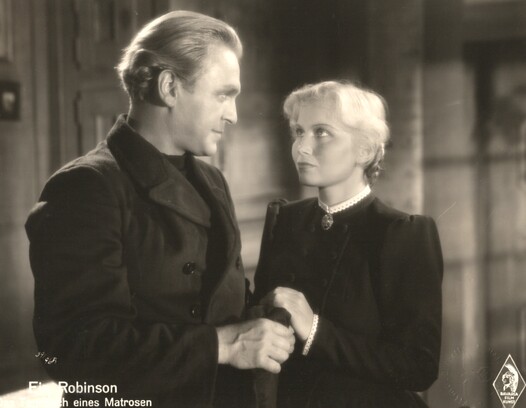
After Ohlsen discovers that his bride (shown above), who gave birth to him of a son, is now married to someone else, he returns to Robinson Island and lives there as a hermit for years until one day the new "Dresden" passes by. After all sorts of adventures, Ohlsen manages to get on the ship, and there he meets his own son in the sailor Pieter, a "capable German sailor", with whom he will be "in rank and file” again from now on.
Historical background:
The film was based on the true story of the “SMS Dresden” which had taken part in the Battle of the Falklands between the Imperial British and Imperial German Navies. Of the eight German ships, only two escaped – the “Seydlitz” and the “Dresden.” The battle took place on December 8, 1914.
The "SMS Dresden" spent three months evading the British but on March 14, 1915, the British Navy found the Germans and attacked. The "SMS Dresden" was in neutral Chilean waters, and the British attack was a violation of international law. But that did not matter to the Brits and was far from their first such deception in WWI. Most of “Dresden’s” crew survived the battle, only 8 men died, but twenty-nine were wounded. The British cruiser “HMS Orama” took 15 German sailors to Valparaiso, and four of them later died. The remaining crew and officers on a German passenger ship were then escorted by two Chilean warships to the remote island of Quiriqunia Island where they were interned for the duration of the war. The future German Intelligence Service chief Wilhelm Canaris was one of the crew.
ABOVE: The island grave site memorial to the "Dresden" sailors who died in the battle or from their wounds thereafter.
The famous Daniel Defoe novel Robinson Crusoe was based on the true 18th century story of the Scottish privateer named Alexander Selkirk. He was marooned for over four years on a little-known island in the Juan Fernandez Archipelago, some 670 Kilometers west of the central Chilean coast. The island chain is not on shipping routes. Historically this island was known as Más a Tierra but was later renamed Robinson Crusoe Island by the Chilean government. That is its name today.
One of the Germans interned on Quiriqunia Island was named Hugo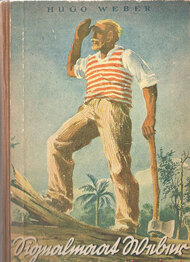 Weber Fachinger. After the war, he stayed in Chile and worked in Patagonia as a wolf hunter. He then moved to Más a Tierra and spent ten years there earning the nickname the “German Robinson.“ A book of his exploits was published in Germany in 1930. It was reprinted during the Third Reich, but bizarrely banned by the Allies and burned in their massive book burnings in 1945. It was only memoirs and had no Nazi propaganda in it whatsoever.
Weber Fachinger. After the war, he stayed in Chile and worked in Patagonia as a wolf hunter. He then moved to Más a Tierra and spent ten years there earning the nickname the “German Robinson.“ A book of his exploits was published in Germany in 1930. It was reprinted during the Third Reich, but bizarrely banned by the Allies and burned in their massive book burnings in 1945. It was only memoirs and had no Nazi propaganda in it whatsoever.
The film script and film–shoot in South America:
Arnold Fanck wove the Daniel Defoe story into that of Fachinger’s service on the “SMS Dresden” and his ten years on the island, and the film script took shape. Fanck and his Bavaria Filmkunst crew and actors took sail to Chile and were away from Germany from September 30th 1938 until April 4, 1939, shooting Ein Robinson. Fanck’s wife and son accompanied him on this adventure. Once in Santiago, the crew was provided free passage by the government on the four-day voyage to Juan Fernandez Archipelago.
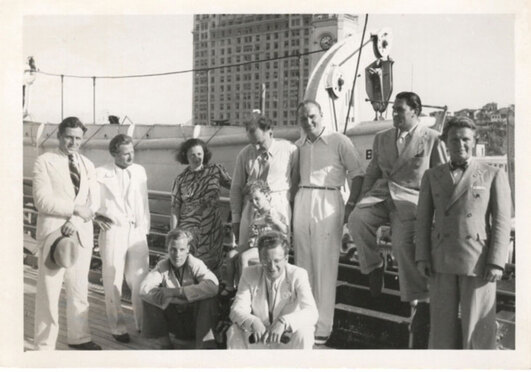
The film production was beset with many challenges and disasters. The Robinson Crusoe Island itself turned out to be flat, bereft of any interesting palm trees or sandy beaches that the Defoe novel inspired, and eventually the team had to locate a better–suited island in the Archipelago. A jungle island perfect for the look of the film.
In the script, a pet parrot that “Robinson” had in his thatched hut on the island was supposed to cry “Robinson, where are you?” in German but despite long hours of attempts at training the bird, it would only say in Spanish “miedre” (“shit.”) Needless to say, that dialogue does not appear in the film.
Weather was a constant problem – on the island chosen there was only 95 minutes of sunshine in fourteen days, according to the memoirs of the chief cameraman, Hans Ertl. Later, the team endured three full weeks of rain and snow when it travelled along the Chilean coast for location shots. (Meine wilden dreißiger Jahre, Hans Ertl. cited throughout this narrative.)
After shooting was completed there, the team returned to Santiago, where they experienced an earthquake. Whilst there, a telegram from Dr. Goebbels arrived stating that the film script had to be changed into a propaganda film championing the German Kriegsmarine. This was no easy task at this point in the film–shoot.
Subsequently, the team travelled along the long Patagonian coast and shot outdoor scenes in a penguin colony, at beautiful waterfalls, and a colony of sea lions. The lead actor, Herbert A.E: Böhme was filmed in these scenes and they were integrated into the story–line. The team also travelled to Tierra del Fuego and took a schooner to the Agostiner Fjord, amongst other locales.
Back in Santiago, a local newspaper erroneously reported that the Fanck ship had been taking photographs along the Chilean coast to send to Nazi Germany on a spy expedition. Both Ertl and his assistant cameraman, Robert Dahlmeier, were arrested as spies and held until a prominent German businessman in Santiago who had met them earlier was able to get the charges dropped. On February 28, 1939, the team took the “Bremen” from Rio to New York, and then on to Germany.
An anti–Semitic scene shot in 1939, but removed from the post-war commercial DVD available today:
Ein Robinson was one of the films that probably included anti-Semitic scenes in the plot without any special instructions from the Propaganda Ministry A small scene with an anti-Semitic accent shows that this film also remains faithful to the National Socialist propaganda of the Weimar Republic down to the last detail: On the way to the train when setting off to emigrate, Ohlsen meets a group of Orthodox Polish Jews who are heavily laden with luggage just arriving. Germany has fallen to the foreigners. They expand within it and dominate it. But the true patriots turn their backs on their fatherland because they can no longer breathe its air. (Die gelbe Stern, Gerhard Schonberner)
Despite Fanck’s reputation as a fine director, and the allure that the storyline and exotic locales the film promised, it only attracted slightly over 4 million audience members and ranked 78th of the 100 top films of the Third Reich in the 1939/40 cinema season. (Begeisterte Zuschauer, Joseph Garncarz).
This Collection has three original posters for the film. A large (A0) sized German poster, a smaller A3 poster, and the Fascist Italy poster for the film (ca. A1).
In our Collection:
We own the Bavaria Filmkunst press book for the film, and 23 lobby cards and 32 private Fanck family photos taken during the Chilean expedition. 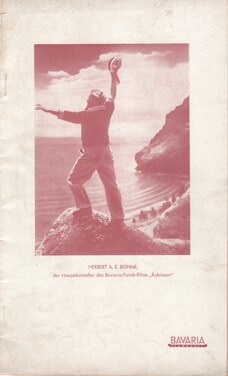 Seven of the lobby card photos are not from the film itself but are 1915 photographs taken of the actual “Dresden’” crew and officers en route to their Quiriqunia Island imprisonment and on the island in their make-shift structures and housing. On April 19, 1940 the film studio sent these photographs in to the German Reich Censorship Office in Berlin (Reichsfilmprüfstelle) asking that they be approved for promotional purposes for the film’s marketing campaign. The Censorship Office forbade any of them to be used. We also own the actual application by the film studio to the Censorship Office for this purpose, and the handwritten response stating that the photos could not be approved. We show a few of these photos below.
Seven of the lobby card photos are not from the film itself but are 1915 photographs taken of the actual “Dresden’” crew and officers en route to their Quiriqunia Island imprisonment and on the island in their make-shift structures and housing. On April 19, 1940 the film studio sent these photographs in to the German Reich Censorship Office in Berlin (Reichsfilmprüfstelle) asking that they be approved for promotional purposes for the film’s marketing campaign. The Censorship Office forbade any of them to be used. We also own the actual application by the film studio to the Censorship Office for this purpose, and the handwritten response stating that the photos could not be approved. We show a few of these photos below.
BELOW, the German "SMS Dresden" sailors en route to their prison island on deck with Chilean sailors, 1915.
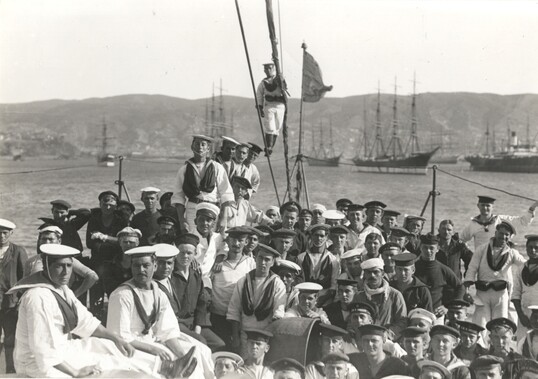
BELOW, the German officers and crew on their island prison.
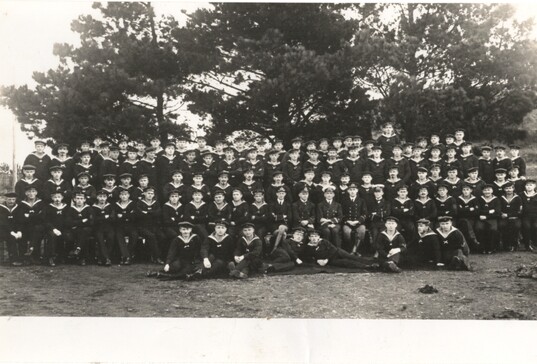
BELOW, the German island carpentry workshop, 1915:
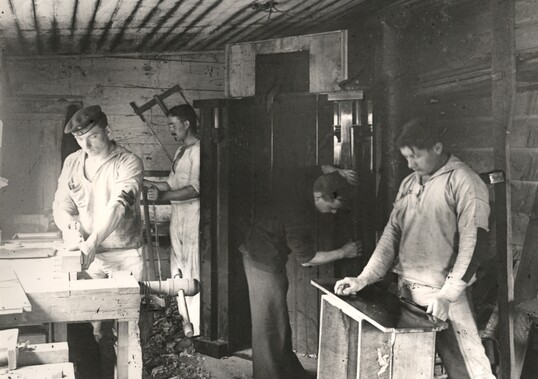
BELOW, the prison music band , 1915:
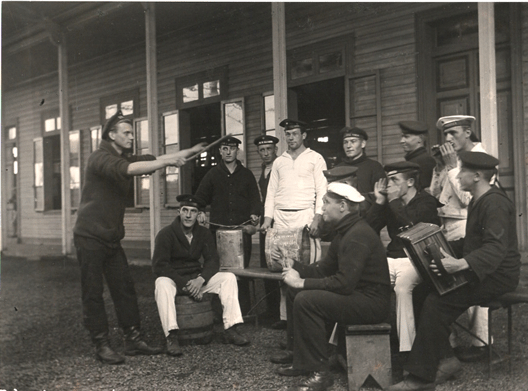
BELOW, the Fanck production team campsite on the island where the set for Robinson was built:
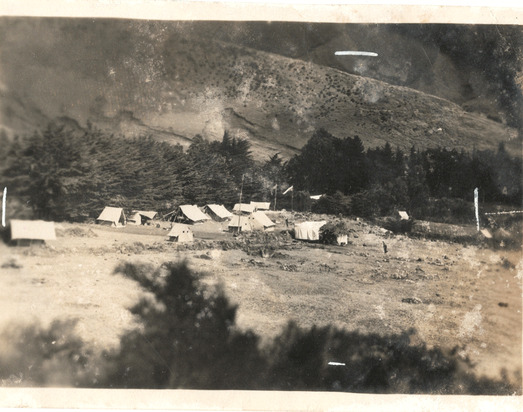
BELOW, Frau Fanck and the Fanck´s oldest son on location 1938:
The 1938/1939 Bavaria film studio preview book exclusively for cinema owners announced the forthcoming film. Note that the main role was tipped to be played by actor Josef Sieber, not Hebert A.E.Böhme.
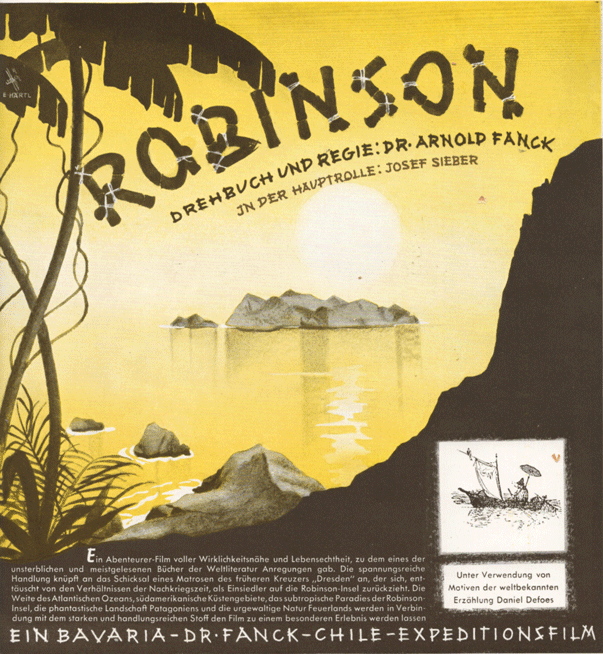
The following Bavaria Filmkunst preview catalogue of 1939/1940 enticed cinema owners to book the film for their movie theater. We have translated the text into English below:
The Bavaria–Fanck–Chile expedition set out on September 30, 1938 to take outdoor photographs of the Histo–African Robinson Island Juan Fernandez, to Patagonia and Tierra del Fuego. On April 4, 1939 she returned to Germany with the “Bremen”. The life that the participants of the expedition led for almost six months was a difficult and renounced one, but also a colorful and varied one. They heard the roaring roar of the sea lions and the roar of the guanacos, the roar and roar of the glacier calving and the thunder-like crackle of the jungle fire. The sensations chased each other, there were new surprises day after day. On ship and on land, now on a swaying sailboat, now on horseback, then again in a motor vehicle or an oxcart, we hunted for motifs that no film has ever shown before. The camera was able to capture an unexpected wealth of the most wonderful natural images, but also grandiose and elementary natural events. In a free recreation, the film partly draws on Daniel Defoe's successful work, which has been translated into all world languages. But the scope of the plot goes far beyond that! Truth and realism are consciously placed in the foreground. A sailor from the German cruiser that was shot down off Robinson Island during the war “Dresden” escapes from internment with other comrades to Germany. However, the conditions of 1918 drove him back again, so that he had to build his life on Robinson Island using the most primitive means until he could return to the Germany of today. This Robinsonade is not invented in its basic features. In addition to the external events of the adventure, the inner experience is placed and the high opinion that no one can change it The national community can and can close its doors. So the film will combine everything in itself: a theme taken from our time, people of our day, adventurous events and experiences full of tension and drama, wonders of a wild, exotic nature, - - a setting and an accusation that are, to a certain extent, historical and occupy a leading place in world literature. The vastness of the Atlantic Ocean, South American coastal areas, the subtropical paradise of Robinson Island, the fantastic landscape of Patagonia and the primeval, remote nature of Tierra del Fuego, the "end of the world", in connection with the strong and action-rich material make the film make it a special experience.
Our three original film posters. The first two are the German posters (A0 and A3 sized) and the third poster is the one from Fascist Italy. They can be found of course in our Poster Gallery, along with some additional background material and photos on the film.
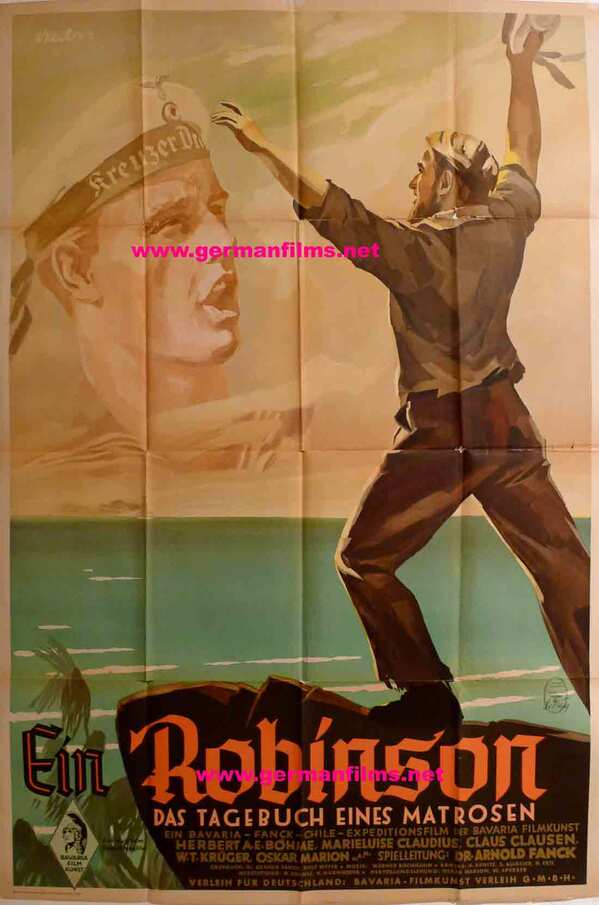
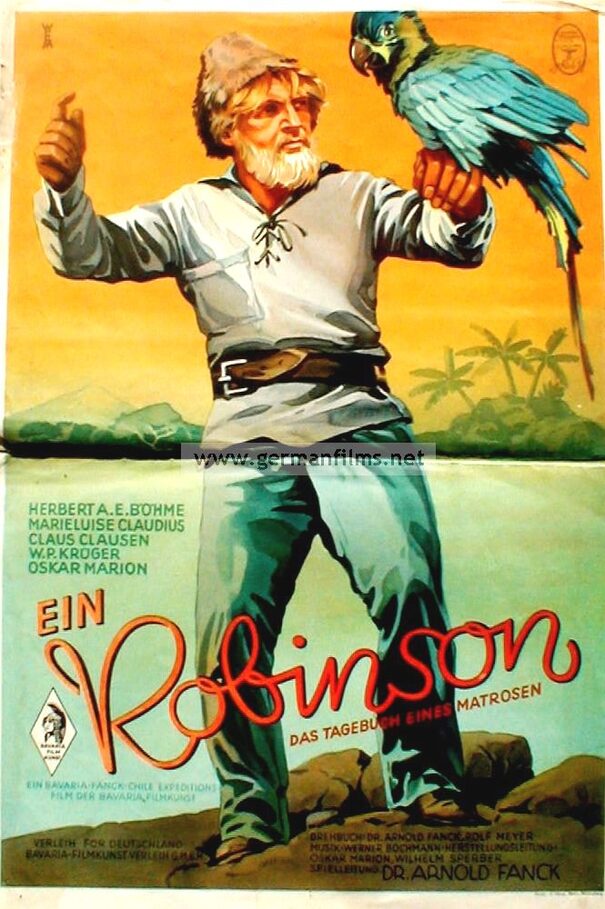
©2023 German Films Dot Net.
